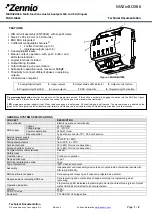UM10850
All information provided in this document is subject to legal disclaimers.
© NXP B.V. 2016. All rights reserved.
User manual
Rev. 2.4 — 13 September 2016
70 of 464
NXP Semiconductors
UM10850
Chapter 4: LPC5410x System configuration (SYSCON)
4.6.4.1 PLL Features
•
Input frequency: Limited to on-chip sources, including the 32 kHz RTC clock and 12
MHz IRC, or up to 24 MHz from the CLKIN pin.
•
CCO frequency: 75 MHz to 150 MHz.
•
Output clock range: 1.2 MHz to 150 MHz. Note that the upper frequency limit of the
PLL exceeds the upper frequency limit of this device.
•
Programmable dividers:
–
Pre-divider. Divide by N, where N = 1 to 256
–
Feedback-divider. Divide by M or 2 x M (where M = 1 to 32768)
–
Post-divider. Divide by 1 or 2 x P, where P = 1 to 32
•
Lock detector.
•
Power-down mode.
•
Fractional divider mode.
•
Spread Spectrum mode.
4.6.4.2 PLL description
A number of sources may be used as an input to the PLL, see
. The PLL input, in
the range of 32 kHz to 24 MHz, may initially be divided down by a value "N", which may be
in the range of 1 to 256. This input division provides a greater number of possibilities in
providing a wide range of output frequencies from the same input frequency.
Following the PLL input divider is the PLL multiplier. The multiplier can multiply the input
divider output through the use of a Current Controlled Oscillator (CCO) by a value "M", in
the range of 1 through 32,768. The resulting frequency must be in the range of 75 MHz to
150 MHz. The multiplier works by dividing the CCO output by the value of M, then using a
phase-frequency detector to compare the divided CCO output to the multiplier input. The
error value is filtered and used to adjust the CCO frequency.
There are additional dividers at the PLL output to bring the frequency down to what is
needed for the CPU, USB, and other peripherals. The PLL output dividers are described
in the Clock Dividers section following the PLL description. A block diagram of the PLL is
shown in
.
All of the dividers use an encoded value, not the binary divide value. The set_pll API (see
) adjusts the value for the main feedback divider (the M divider), but does
not accept pre- and post-divider values. See section
for information on how to obtain divider values.
4.6.4.2.1
Lock detector
The lock detector measures the phase difference between the rising edges of the input
and feedback clocks. Only when this difference is smaller than the so called “lock
criterion” for more than eight consecutive input clock periods, the lock output switches
from low to high. A single too large phase difference immediately resets the counter and
causes the lock signal to drop (if it was high). Requiring eight phase measurements in a
row to be below a certain figure ensures that the lock detector will not indicate lock until
both the phase and frequency of the input and feedback clocks are very well aligned. This
effectively prevents false lock indications, and thus ensures a glitch free lock signal.


















